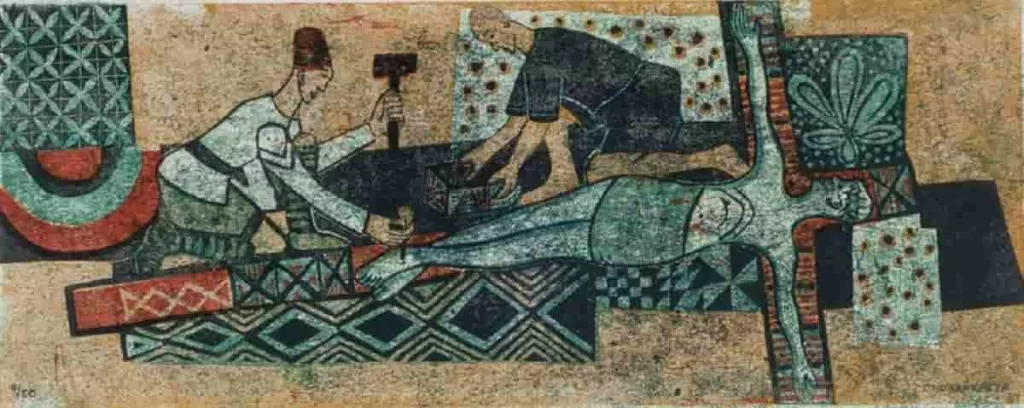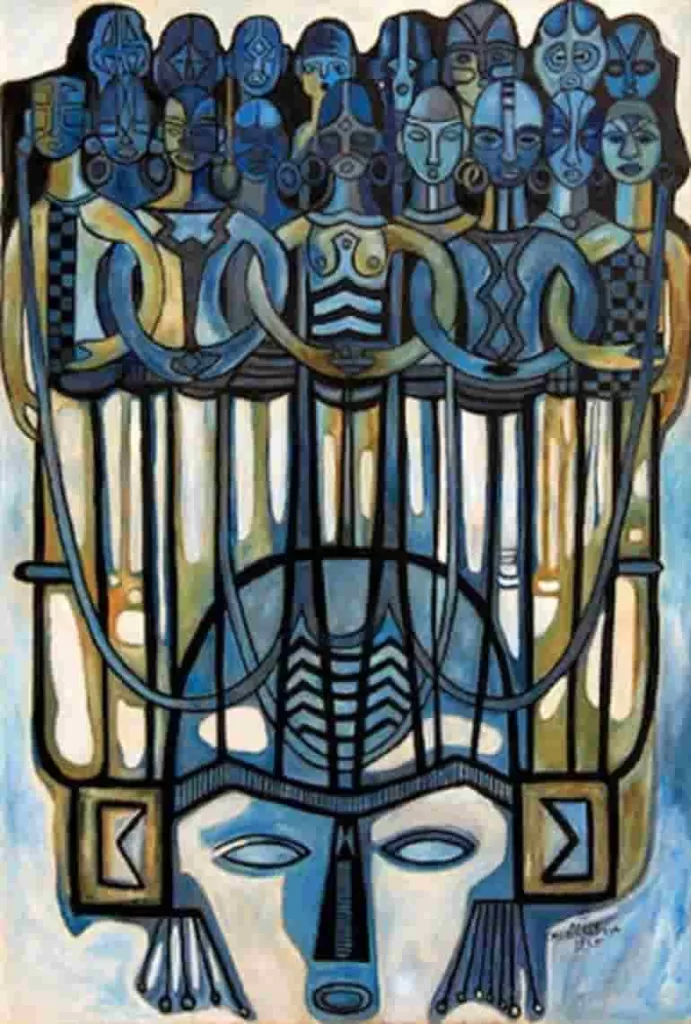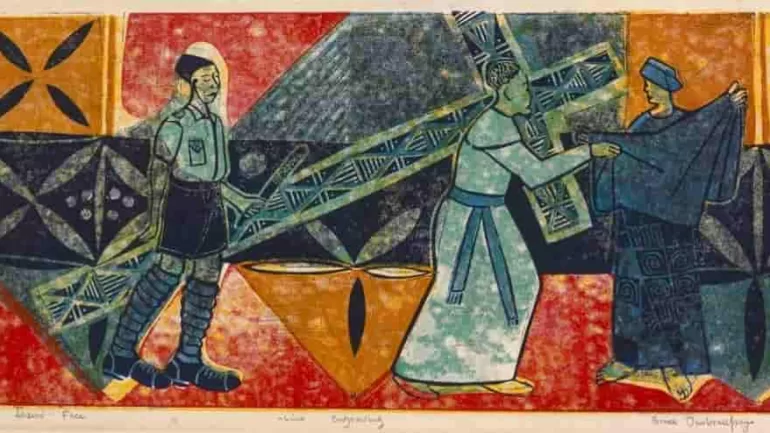ART & DESIGN
Station VI: Veronica Wipes the Face of Jesus, 1969 by Bruce Onobrakpeya. It depicts this bible story using traditional Nigerian motives. Linoleum block print on rice paper 11 7/8 x 25 3/8 inches. Image: High Museum
Bruce Onobrakpeya’s first major solo exhibition in a U.S. museum explores the powerful intersection of Christian faith and Nigerian traditions through his captivating art.
BY KAZEEM ADELEKE, ARTCENTRON
After many years of neglect, an American museum is finally giving Bruce Onobrakpeya the recognition he truly deserves. Currently on display at the Smithsonian’s National Museum of African Art is the exhibition Bruce Onobrakpeya: The Mask and the Cross. Originally organized at the High Museum of Art in Atlanta, the exhibition marks the artist’s first major solo exhibition in a U.S. museum. It features seminal works by this important figure in Nigerian modernism and a trailblazer in postcolonial African art.
Bruce Onobrakpeya: The Mask and the Cross focuses on multiple aspects of Onobrakpeya’s work, but more importantly, the symbiotic relationship between art and Christianity. Within Nigerian art, it is essential to acknowledge the Catholic Church‘s profound influence, despite only a small percentage of Nigerians identifying as Catholic. The transition of the Holy See’s delegation to Lagos in 1960 marked a vital moment in the intersection of faith and artistry within Nigeria.
The Context of Christianity in Nigeria
Although Nigeria is a country rich in cultural diversity, the church’s involvement has evolved significantly over the decades. While only approximately twelve percent of the population identifies as Catholic, the Church’s influence on the artistic landscape is undeniable. At the core of this influence was the clergy. The clergy’s involvement in the arts fostered a unique blend of indigenous and religious themes, creating a distinctive narrative within the artistic community through the years.
One of the major figures in this artistic renaissance was Father Kevin Carroll, a missionary priest who established art workshops across Nigeria. Through his initiative with the Society of African Missions, Carroll commissioned significant works that contributed to the fusion of traditional Nigerian art and Christian themes.
A major section of this show highlights the influence of Christianity on Nigerian art and its impact on Bruce Onobrakpeya’s works. The artist’s work from 1966 to 1978 includes important commissions for the Catholic Church. One of them is the Fourteen Stations of the Cross. In 1967, Father Kevin Carroll approached Onobrakpeya to create a mural depicting the Fourteen Stations of the Cross for St. Paul’s Church in Lagos. This collaboration was about more than creating religious art; it contextualized Christianity within a Nigerian framework.
Juxtaposes Biblical Narratives with Nigerian Life

In executing this art project, Onobrakpeya juxtaposes biblical narratives against the backdrop of Nigerian life. One remarkable work in the project that exemplifies this approach is Station XI: They Nail Jesus to the Cross 1969. Using linoleum block print techniques on rice paper, Onobrakpeya depicts the intense emotions of the Crucifixion while incorporating elements of Nigerian art. Using indigo and adire motives and masks found in many Nigerian cultures, the artist presents the crucifixion in a manner that resonates with Nigerian culture. With this dynamic integration of cultural elements and forms, the artist challenges viewers to perceive familiar Christian stories through a local lens. More importantly, he invites them to engage deeply with the narrative.
Fusion of Christian Iconography and Nigerian Culture
Onobrakpeya’s work represents a compelling fusion of Christian iconography and Nigerian cultural motifs. However, they do more than simply depict Christian stories; they reinterpret them. By embedding local symbols and narratives, they resonate with the Nigerian audience. In creating his themes on Christianity, the artist often employs motifs from Nigerian folklore and culture. This way, he enriches the religious message with cultural significance. This practice enables a broader interpretation of faith that is accessible and relatable to a predominantly non-Western audience.
Onobrakpeya’s techniques are integral to understanding his artistic message. He employs a range of materials and methods that reflect both traditional and contemporary practices. His use of color, form, and texture creates a dynamic interplay that invites viewers to engage with the works on multiple levels. This is particularly evident in his representation of the Stations of the Cross. Each station is imbued with a unique narrative that speaks to the viewer’s personal and cultural experiences.
Interrogating Topical Social Issues
Onobrakpeya’s works do not exist in a vacuum; they respond to the socio-political climate of the country. His works skillfully blend Christian iconography with traditional motifs, providing the opportunity to critique and interrogate topical social situations. Several of his works of art reflect the broader context of decolonization in Nigeria. For example, his depiction of the Passion of Christ includes Roman soldiers dressed in British military uniforms while Jesus wears traditional Nigerian attire. The piece directly addressed the subjugation and violence of the British colonialists on innocent Nigerians. In an insightful statement, Onobrakpeya expressed his mission: to “make Christ accessible to our people.”
By incorporating Christian themes, Onobrakpeya provides a reflective space for viewers to contemplate their identities in the face of changing cultural landscapes. The dialogue between faith and culture that he fosters encourages deeper engagement with both. His pieces are a bridge, connecting Western Christian narratives with African traditions. This synthesis allows for a richer understanding of Christianity within the context of Nigerian spirituality and cultural heritage.

Honoring Bruce Onobrakpeya: A Visionary Artist
Bruce Onobrakpeya: The Mask and the Cross celebrates the artist’s remarkable contributions to the art world and his influence on subsequent generations of Nigerian artists. Curator Janine Gaëlle Dieudji highlights the exhibition’s significance: “It celebrates the illustrious career of Dr. Bruce Onobrakpeya and explores the spiritual dimensions of African art.”
A dedicated section of the exhibition features contemporary Nigerian printmakers who also explore themes of faith and spirituality through the lens of African heritage. Artists such as Rufus Ogundele combine Christian themes with Yoruba traditions, creating a rich narrative tapestry. Others include Adebisi Fabunmi, Yinka Adeyemi, Solomon Irein Wangboje, and Oluwole Olayemi. John K. Lapiana, the interim director of the museum, emphasizes the importance of this dialogue among artists. He notes that it reflects the museum’s mission to examine cross-cultural influences and celebrate Africa’s diverse artistic heritage.
The Life and Work of Bruce Onobrakpeya
Bruce Onobrakpeya was born on August 30, 1932, in Agbarha-Otor, Delta State, Nigeria. His artistic journey began at the Nigerian College of Art, Science and Technology in Zaria. There, he co-founded the Zaria Arts Society in 1958. This group aimed to decolonize Nigerian visual arts, creating a “natural synthesis” of traditional African art and Western techniques.
Onobrakpeya held his first solo exhibition in 1959, showcasing his innovative approach. Following Nigeria’s independence in 1960, his contributions to the Nigeria Exhibition positioned him as a key figure in the artistic landscape.
Onobrakpeya’s style evolved through academic training and experimentation. Influenced by artists like Paul Gauguin, he began integrating local Nigerian themes into his work. His notable pieces from this period include Palm Wine Women (1965) and Eclipse (1967). In the late 1960s, he pioneered the plastograph technique during printmaking workshops, establishing a new artistic identity.
Onobrakpeya’s work often bridges literature and visual arts. In 1963, he illustrated Chinua Achebe’s No Longer at Ease, expanding his influence. The Nigerian Civil War (1967–1971) greatly impacted Onobrakpeya’s art. His piece Have You Heard? (1970) reflects the social turmoil of that era, illustrating how conflict shapes artistic expression.
In the late 1970s, Onobrakpeya explored historical civilizations, especially the Benin Kingdom. His work from this period showcases his respect for heritage and evolving artistic style. The Sahelian Masquerades Series highlights environmental challenges in North Africa, emphasizing his commitment to social issues.
Multimedia and Environmental Advocacy
In response to the execution of activist Ken Saro-Wiwa in 1995, Onobrakpeya created works like Nudes and Protest (1995–2007), reflecting contemporary social movements. He also embraced multimedia installations, merging traditional art with modern materials in pieces like Hunter in the Rain Forest (2007).
Bruce Onobrakpeya: A Cultural Synthesis
Bruce Onobrakpeya’s artistic journey showcases his dedication to cultural synthesis and social commentary. His ability to blend traditional Nigerian motifs with modern techniques has earned him international acclaim. Through his impactful work, he continues to inspire new generations of artists and enrich the global art landscape.
Visit the Exhibition
The Bruce Onobrakpeya: The Mask and the Cross exhibition runs through January 21, 2025. Don’t miss the chance to explore the legacy of one of Africa’s most influential artists and engage with the spiritual and cultural richness of Nigerian art.
